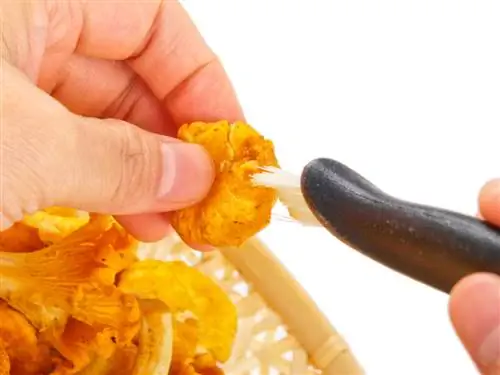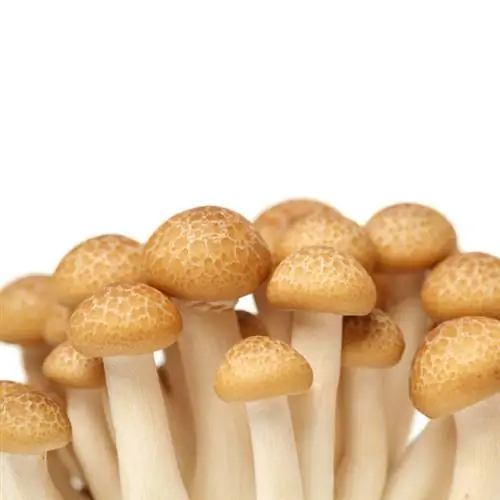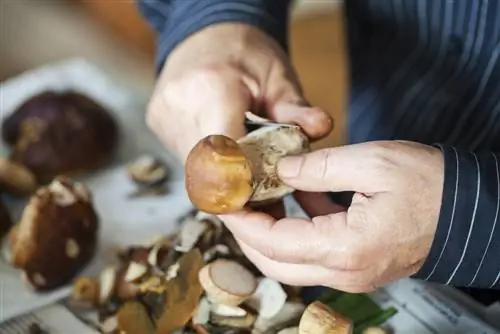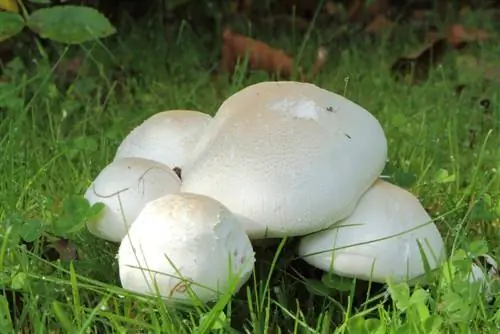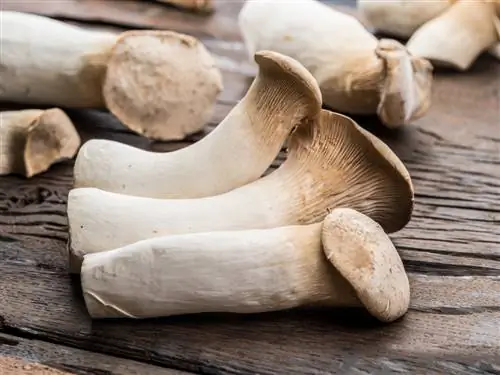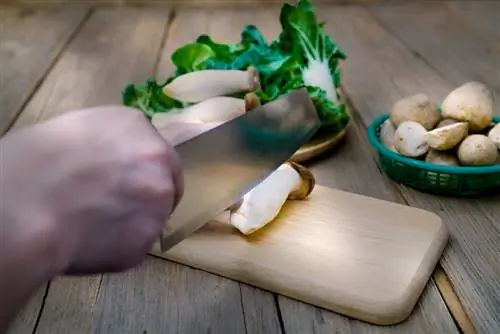- Author admin [email protected].
- Public 2023-12-16 16:46.
- Last modified 2025-06-01 06:02.
The time has come around June: with a bit of luck, you can take the bright yellow chanterelles home with you during a walk in the forest and use them to make a tasty mushroom meal. Due to their characteristic appearance, these mushrooms in our latitudes can only be confused with false chanterelles, which, however, are not poisonous and therefore harmless. But be careful: In some regions the population of the mushrooms, also known as “chanse mushrooms”, has declined sharply, which is why they can only be collected for your own use and not in large quantities.
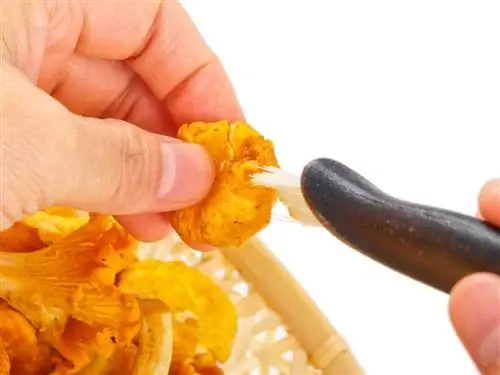
How do you clean chanterelles correctly?
To clean chanterelles properly, you should brush them gently instead of washing them. Use a mushroom brush and a clean kitchen towel to remove stubborn dirt. If the chanterelles are very dirty, you can use the “flour trick” in which the mushrooms are coated in flour and then rinsed.
First cleaning already takes place in the forest
Chanterelles prefer sunny places - and like to hide there in the middle of a damp moss cushion, as they often find along forest paths. Although the typical yellow caps of larger specimens can often be seen from a distance, you have to look for the much more common small ones in their moss bed by carefully pulling it apart with your fingers. Due to their hidden location, chanterelles that you have collected yourself often have a lot of dirt stuck to them: soil, sand, tree needles (the delicious mushrooms are often found near pine trees), moss residue and sometimes smaller insects. This is not the only reason why the first cleaning takes place in the forest:
- Carefully twist the mushrooms out of the ground or cut them off directly above the ground.
- Check and sort chanterelles for authenticity
- False chanterelles can be distinguished quite easily, for example by the lack of smell
- Just leave unsuitable or incorrect chanterelles lying on the forest floor
- so you can continue to multiply through spores that fall out
- Check mushrooms for maggot infestation (cut larger specimens lengthwise)
- clean off the coarsest dirt with a brush or similar
Never transport chanterelles or other wild mushrooms in a plastic container or bag, they will take offense to that. An airy basket lined with a cotton cloth is best suited or, in an emergency, a cotton or jute bag.
Cleaning chanterelles correctly - this is how it’s done
Once you get home, you should clean the chanterelles immediately and prepare them for further use - like all mushrooms, they can only be stored in the refrigerator for a few days. If it is not possible to use them immediately, at least clean them roughly and then store them in the vegetable compartment of the refrigerator. Do not leave fresh or already prepared mushrooms at room temperature for a long time - if you are unlucky you can quickly catch food poisoning.
Brush - do not wash
Like almost all mushrooms - with the exception of species such as the curled hen - you should, if possible, not wash mushrooms when cleaning them. Mushrooms naturally contain a lot of water - and thanks to their special structure, they absorb further moisture like a sponge. This is also the reason why they are called “Schwammerl”, especially in the south of Germany and Austria. Instead of washing them, it is best to brush the chanterelles individually with a mushroom brush and clean stubborn dirt by rubbing with a clean kitchen towel. However, only apply light pressure - chanterelles are very sensitive and quickly develop unsightly pressure points. Cut away dry and mushy areas with a sharp vegetable knife.
Wash only if very dirty
However, if the mushrooms are very dirty and/or you have collected very large quantities, cleaning them by hand can be very laborious. In this case, you can also wash the chanterelles, but you should never water the mushrooms. Only expose them to water for a short time and then dry them thoroughly with a clean kitchen towel. The best way to wash chanterelles is this: Place the mushrooms in a sieve, such as a pasta sieve, and rinse them thoroughly with a powerful jet from the hand shower.
Trick for large quantities: Clean the chanterelles with flour
The “flour trick” has proven particularly useful for heavily contaminated or larger quantities of chanterelles:
- Always put small amounts of mushrooms into a freezer bag.
- Dust the mushrooms with one to two tablespoons of flour.
- Seal the bag and shake the contents vigorously.
- Now pour the floured mushrooms into a sieve and shake it.
- The flour binds the dirt that falls off when you shake.
- Carefully shower off the residue with the hand shower (for example in the shower).
Don't forget to dry the mushrooms carefully so that they don't absorb the moisture and lose their consistency and taste.
Cut and process chanterelles correctly
Once the chanterelles are finally clean, you can cut them and prepare them. You can leave smaller specimens whole, only larger ones should be halved or even divided into thirds. Cutting into slices, on the other hand, is only necessary for certain applications (e.g. drying in the oven or on a string). Prepare the mushrooms as fresh as possible: If this is not possible, you can also store them in the vegetable compartment of your refrigerator for three to four days.
Tip
If you can't process the chanterelles straight away, the mushrooms can also be frozen or preserved in another way.

